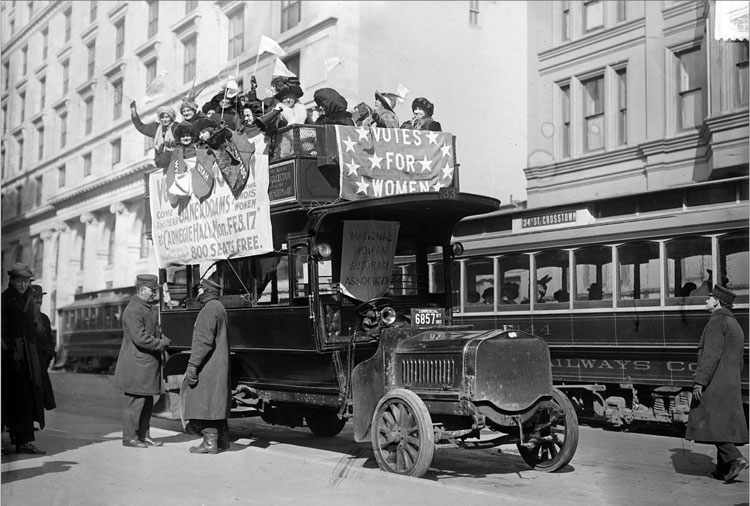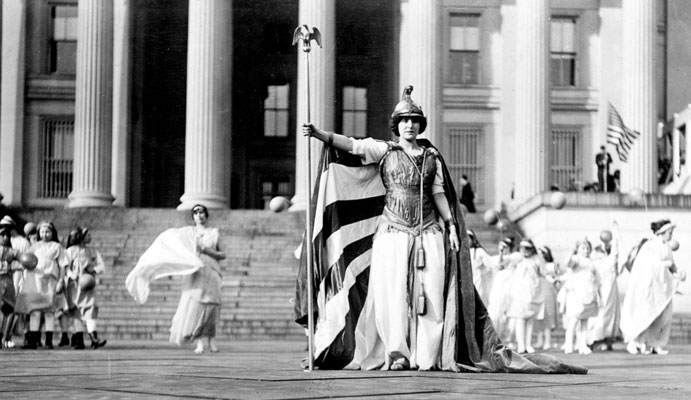Photo Courtesy Library of Congress: The German actress Hedwig Reicher wears the costume of “Columbia,” with other suffrage pageant participants standing in the background, in front of the Treasury building in Washington, D.C., on March 3, 1913. The performance was part of the larger suffrage parade of 1913.
Column By ERA Task Force
When the Constitution was adopted “We the People of the United States…” did not include women. Women could not vote and had no existence in the Constitution.
At the 1848 women’s rights convention in Seneca Falls, the movement for the vote began its 72-year sojourn. It was first introduced in Congress in 1878 by California Senator Aaron A. Sargent at the behest of Elizabeth Cady Stanton and Susan B. Anthony. Opposition to voting by women was widespread and the amendment did not see the light of day again until 1914. In May 1919, two-thirds of Congress voted in favor of the amendment; it was sent to the states for ratification. We have heard the story of how Tennessee became the 36th state on Aug. 20, 1910, when Harry Burn, a 24-year-old legislator switched his vote to passage on the urging of his mother. Then as now, those opposing women’s rights tried to stop it.
While the American women’s voting rights movement consisted mainly of civil disobedience many of the women were arrested, imprisoned, beaten, hung by their thumbs, fed worms, and went on hunger strikes. August 26 the Secretary of State signed a proclamation certifying the passage at 8 a.m. in his own house behind closed doors. Alice Paul and Carrie Chapman Catt had asked for women to be there and to publicize the event but allegedly the Secretary was aware of the rivalry between the two and wanted to avoid any confrontations. The New York Times ran a front-page story about the lack of fanfare. Then as now, government officials are delaying the publication.

In 1971, Bella Abzug introduced a resolution in Congress to designate August 26 as Women’s Equality Day. It also commemorates the 1970 Women’s Strike for Equality on the 50th anniversary of the passage of women’s suffrage. That strike was for equal pay and decent working conditions. It is shameful that today we are still fighting for the Equal Rights Amendment (ERA) granting women full legal equality and formally added to the Constitution.
In the original Constitution, all males did not have voting rights. Not until the 14th Amendment was passed in 1868 but even then, they didn’t get the “right” to vote only the right not to be refused. “When the right to vote at any election … is denied to any of the male inhabitants …the basis of representation therein shall be reduced …” That was a warning to the Southern States that if they denied the vote to Blacks, their number of representatives in Congress would be reduced. The Fifteenth Amendment specifically said the vote shall not be denied to men on the basis of race, color, or previous condition of servitude. That never stopped the Confederacy.
The court made it perfectly clear in 1874 that women were not covered under the Fourteenth Amendment. In Minor v. Happersett the court ruled that women are citizens but that has nothing to do with voting and the passage of the Fourteenth Amendment changes nothing. Though women did have to do jury duty and pay taxes, we could not vote. The 14th amendment was first understood only to cover those previously held under slavery. But 21 years later it was broadened to protect corporations in Minneapolis v. St. Louis Railroad & Beckwith (1889). The court ruled that corporations are persons for purposes of the application of the equal protection and due process clauses of the Fourteenth Amendment. Not until 82 years later in Reed v. Reed (1971) were women – actual persons – covered under the 14th. But the court ruled in U.S. v. Virginia (1996) that the analogy has its limits and does not extend complete protection for women under the Constitution. After that case, it became obvious that only the 28th amendment (ERA) will correct the mistake made in the 14th amendment.
The sojourn of the ERA has been even longer than that of the voting amendment – 98 years and running. It was first introduced in 1923 but not heard in Congress until 1972. Thirty-five states had ratified by 1979 until the Koch brothers’ money and Phyllis Schlafly, an attorney denied advancement in the career she really wanted, stepped in. The final three ratifications were obtained from Nevada in 2017, Illinois in 2018, and Virginia in January 2020. As with the 19th Amendment, the national archivist is holding up the publication. Two lawsuits have been filed and more can be expected. It’s hard to believe that in the 21st-century women still have to fight to correct their omission from the Constitution and be considered full citizens.







